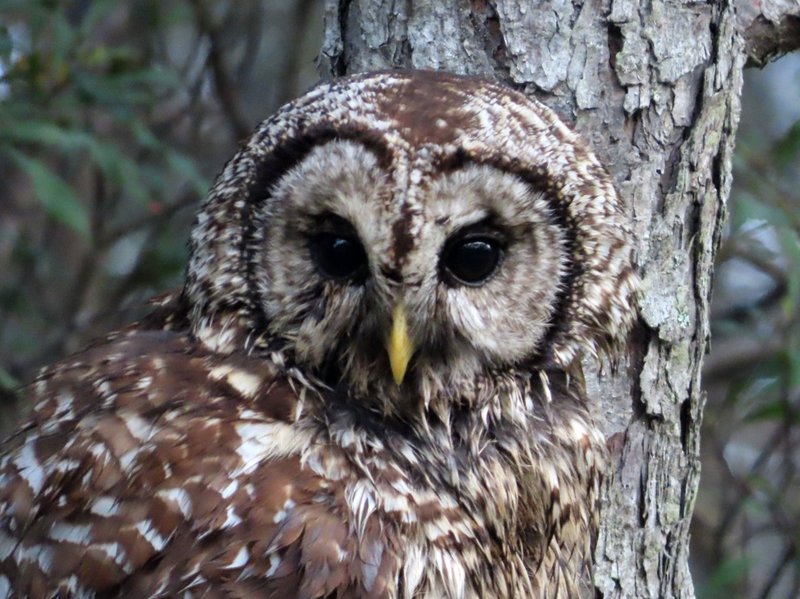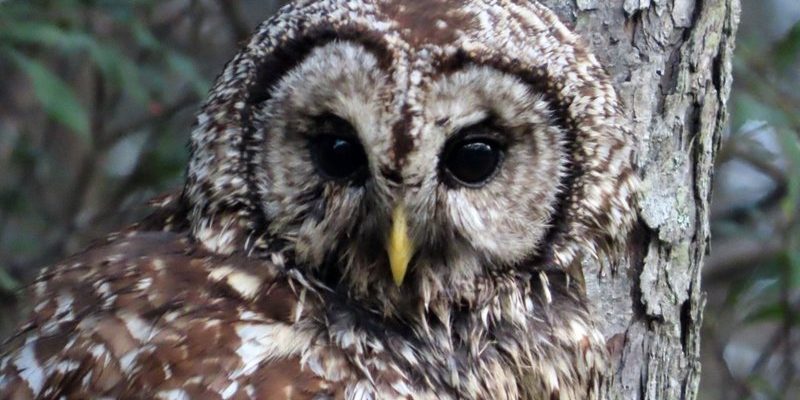
Identifying a barred owl in the wild isn’t just about knowing what they look like. It’s about recognizing their habits, sounds, and the environments they thrive in. Just as you would learn the nuances of a friend’s voice or the way they laugh, getting to know barred owls takes a bit of observation and patience. So, if you’re intrigued and want to take your wildlife spotting up a notch, let’s dive into the world of barred owls and explore how to identify them in their natural habitat.
Recognizing the Physical Features of Barred Owls
Barred owls are medium-sized birds that are fairly easy to identify once you know what to look for. Their most distinguishing feature is their brown and white striped plumage, which helps them blend into the tree bark of their wooded homes. If you think of them as nature’s camouflage experts, you’re on the right track.
Their heads are round, and they have a flat facial disc, which is often bordered by a dark rim. This gives them a uniquely expressive face. Keep an eye out for their big, dark eyes which seem to absorb the light, making them exceptionally adept at hunting at night. A great way to remember their look is to think of them as little furry sentinels perched quietly, observing the world around them.
In terms of size, barred owls usually weigh between 1.1 to 2.6 pounds and stand about 16 to 25 inches tall. If you see an owl that looks a bit like a plush toy, it’s probably a barred owl! Their wingspan ranges from about 38 to 49 inches, which is substantial but not overwhelming.
Understanding Their Habitat and Range
You might be wondering where to look for these fascinating birds. Barred owls prefer mature forests, especially mixed woodlands that include both deciduous (think trees that lose their leaves) and evergreen trees. They also like areas near water, such as swamps or marshes, where they can easily find their favorite meals: small mammals, birds, and even amphibians.
During the day, you’ll often find them resting on horizontal branches. They like to perch around 30 to 50 feet high, which can make spotting them a bit tricky. If you’re wandering through the woods, pause every now and then to scan the branches above you. It’s like a game of hide-and-seek!
Barred owls are found across much of North America, from southern Canada to the northern parts of Mexico. If you’re in these areas, you stand a good chance of encountering them. Remember that they are nocturnal, which means they’re most active at night, so a little late-night adventure might pay off if you’re eager to catch a glimpse.
Listening for Their Unique Calls
One of the best ways to identify a barred owl isn’t by sight but by sound. Their calls are distinctive and memorable. If you hear a series of rhythmic hoots sounding like, “Who cooks for you? Who cooks for you all?” that’s your clue! They often call during mating season in late winter and early spring, but they might vocalize at any time.
These calls serve many purposes, from warding off rivals to attracting mates. If you’re out in the woods, take a moment to stop and listen. The silence of the forest can be enchanting, but when a barred owl starts to call, it transforms the experience into something magical.
If you want to practice your owl calls or mimic their sounds, remember that they have a few variations. Some might sound raspy, while others might have a more melodious tone. It’s like they have their own dialect!
Spotting Barred Owls During the Day
Hunting for barred owls during the day can be a fun challenge. Since they are primarily nocturnal, daytime sightings are less common but definitely possible. Start your adventures during dawn or dusk when they might still be waking up or settling down for the night.
Look up into the trees and scan for those unique shapes. Their coloration helps them blend in, but their round heads can sometimes give them away. You might also notice movements—like the flutter of wings or a slight shift in their perch.
It’s helpful to use binoculars for a closer look. Don’t forget to keep your voice down! Barred owls might get startled and fly away if they sense human presence. Think of yourself as a quiet observer in their world, respecting their space while enjoying the view.
Understanding Their Behavior and Feeding Habits
Barred owls are known for being less shy compared to other owl species. They often sit in plain sight, giving birdwatchers a thrill. When it comes to hunting, these owls rely heavily on their keen hearing and excellent vision to detect prey, especially in low light.
They typically hunt from a perch, waiting patiently for an unsuspecting victim to cross their path. Once they spot something, they’ll swoop down with impressive stealth and precision. It’s like they’re nature’s ninjas!
During the day, you might see them preening their feathers or sitting silently. It’s fascinating to observe how they interact with their environment. Sometimes, they might even engage in a little ‘owl conversation’ with fellow barred owls.
Using Equipment to Enhance Your Owl-Watching Experience
If you’re serious about spotting barred owls, a few tools can elevate your experience. Binoculars are a must-have. They allow for a closer look without compromising the owl’s space. Look for models with a good field of view and light-gathering ability for those dusky moments.
A field guide with pictures and descriptions can also be your best friend. It helps in identifying not just barred owls but other wildlife you might encounter. Think of it as your personal adventure companion.
Consider bringing a notebook to jot down your observations. This practice helps solidify your experiences and even track any patterns you notice. For example, do you see more owls in a particular season or location? This kind of journaling enriches your understanding and connection with nature.
The Importance of Conservation and Respecting Their Habitat
As you embark on your quest to identify barred owls, it’s vital to remember the importance of conservation. These majestic birds play a crucial role in the ecosystem by controlling rodent populations and contributing to the balance of nature. Preserving their habitat is not just about saving the owls; it’s about maintaining a healthy environment for all wildlife.
Be mindful of the areas you visit. Stick to marked trails and avoid disturbing nesting sites. If you’re lucky enough to spot a barred owl, enjoy the moment, but keep your distance. It’s all about creating a respectful relationship with these wild creatures.
By understanding their needs and protecting their habitats, we can ensure that future generations will also have the opportunity to witness the beauty of barred owls in the wild.
In conclusion, identifying a barred owl in the wild is as much about what you see and hear as it is about the experience you create. With a little knowledge and a lot of patience, you’ll soon find yourself not just spotting these wonderful birds but truly appreciating their place in the natural world. So grab those binoculars, head into the woods, and immerse yourself in the adventure of wildlife observation!

